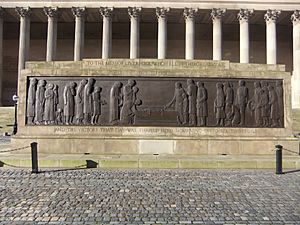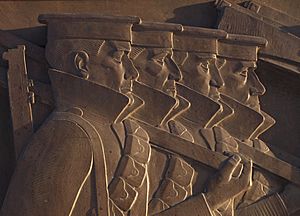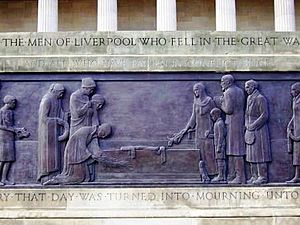Liverpool Cenotaph facts for kids
Quick facts for kids Liverpool Cenotaph |
|
|---|---|

Liverpool Cenotaph with the columns of St George's Hall behind
|
|
| Location | St George's Plateau, Liverpool, England |
| Built | 1927–30 |
| Architect | Lionel Bailey Budden |
| Sculptor | Herbert Tyson Smith |
|
Listed Building – Grade I
|
|
| Official name: Liverpool Cenotaph | |
| Designated | 8 November 2013 |
| Reference no. | 1073463 |
The Liverpool Cenotaph is a special monument in Liverpool, England. It stands on St George's Plateau, right next to the famous St George's Hall. A cenotaph is like a tomb or monument built to honor people who died in a war, especially if their bodies are buried somewhere else.
This cenotaph was built to remember the soldiers from Liverpool who lost their lives in the First World War. Later, the dates for the Second World War were added too. The monument is a large stone block on a platform. It has amazing bronze sculptures on its sides. These sculptures show marching soldiers and people mourning their loss.
Lionel Budden designed the cenotaph. The detailed carvings were done by Herbert Tyson Smith. It was first listed as a Grade II building, meaning it was important. But in 2013, its status was raised to Grade I, showing it's one of the most important historic buildings in England.
Building the Cenotaph
In 1926, a contest was held to find the best design for a war memorial. Money for the memorial came from public donations. Charles Reilly, an architecture professor, helped choose the winner.
Many people entered the contest, but the winning design came from Lionel Budden. He was actually Reilly's assistant! The building work was done by A. E. Bradley and Company. Herbert Tyson Smith created the bronze sculptures. These sculptures were made at the Morris-Singer Company's foundry.
The Liverpool Cenotaph was officially revealed on 11 November 1930. This happened at 11 AM, a special time because the First World War ended on the 11th hour of the 11th day of the 11th month. The 17th Earl of Derby unveiled it.
After the Second World War ended, the years 1939 and 1945 were added to the cenotaph. These new dates were unveiled on Remembrance Sunday, 10 November 1946. The Lord Mayor of Liverpool at the time, William G. Gregson, did the honors.
What the Cenotaph Looks Like
The cenotaph is made from a rectangular block of Stancliffe stone. It has bronze sculptures on its sides. This stone block sits on a platform made of Yorkshire Silex stone.
The main stone block is about 11 meters (35 feet) long and 3.3 meters (11 feet) high. The bronze panels are about 9.4 meters (31 feet) long. The entire platform is about 18.6 meters (61 feet) long and 4.5 meters (15 feet) deep. It faces the same direction as St George's Hall.
On the side facing St George's Hall, there's a bronze sculpture. It shows a long line of marching soldiers. They are wearing the uniforms of different parts of the armed forces. Above this panel, there's an inscription that says: "AS UNKNOWN AND YET WELL KNOWN AS DYING AND BEHOLD WE LIVE". Below it, another inscription reads: "OUT OF THE NORTH PARTS A GREAT COMPANY AND A MIGHTY ARMY".
On the other side, facing Lime Street station, the bronze panel shows people mourning. They are placing flowers and wreaths on a Stone of Remembrance. Behind them, you can see rows of graves in a military cemetery. Above this panel, the inscription says: "TO THE MEN OF LIVERPOOL WHO FELL IN THE GREAT WAR". An added line below it reads: "AND ALL WHO HAVE FALLEN IN CONFLICT SINCE". Under the panel, it says: "AND THE VICTORY THAT DAY WAS TURNED INTO MOURNING UNTO ALL THE PEOPLE".
On the shorter ends of the cenotaph, there are round bronze shields. These shields show the coat of arms of Liverpool and decorative garlands. They also have the dates of the two World Wars.
Why the Cenotaph is Important
The Liverpool Cenotaph was first recognized as an important building on 28 June 1952. It was given a Grade II listing. Then, on 8 November 2013, its importance was recognized even more. It was upgraded to a Grade I listed building. This means it's considered one of the most important historic sites in the country.
There are many reasons why it's so highly valued. Its location next to St George's Hall is very impressive. The way it's designed, with its horizontal lines, creates a nice contrast with the tall columns of the hall.
The sculptures on the cenotaph are also considered outstanding. Many people believe they are some of Herbert Tyson Smith's best and most powerful work. The design is special because it doesn't use old-fashioned symbols or heroic ideas. Instead, it shows real and powerful scenes.
The craftsmanship of the cenotaph is also excellent. It is also important because it is located near other historic buildings. In the famous Pevsner Architectural Guides, Sharples says that it is "one of the most remarkable war memorials in the country."
See also
 In Spanish: Cenotafio de Liverpool para niños
In Spanish: Cenotafio de Liverpool para niños



